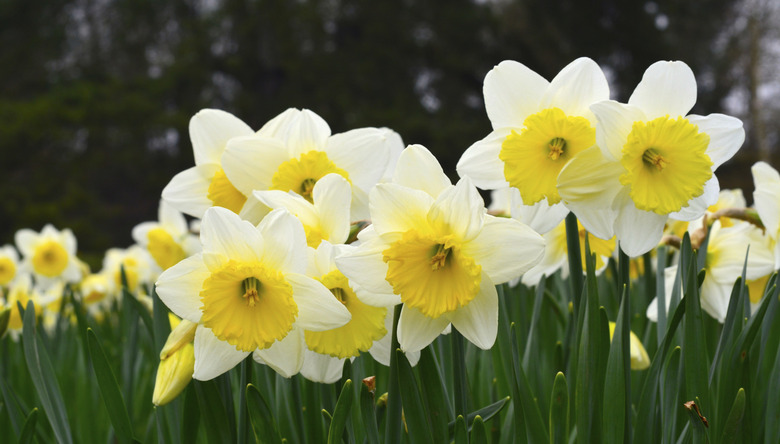How To Identify Jonquils And Daffodils
Once you've seen daffodils (Narcissus spp.) "fluttering and dancing in the breeze," you'll have as hard a time forgetting them as the poet William Wordsworth did. Maybe it's the bright, gay yellow color of the outer leaves behind the orange corona, or the way the flower heads seem to nod happily in the wind. Given the over 14,000 daffodil cultivars, horticulturists separated them into 14 divisions for identification. Division 7 daffodils are the jonquils (Narcissus jonquilla), and although they do not bear the division number when they toss heads in a field or garden, you'll have no trouble identifying them.
Step 1
Count the flowers on a stalk. Generally, daffodils grow one big blossom atop a green stalk, but jonquils have several smaller blooms — up to eight in some cultivars. The petals and corona of jonquils are often the same color.
- Once you've seen daffodils (Narcissus spp.)
- " Division 7 daffodils are the jonquils (Narcissus jonquilla), and although they do not bear the division number when they toss heads in a field or garden, you'll have no trouble identifying them.
Step 2
Inspect the foliage. Most daffodils have long, flat leaves. Jonquil leaves resemble reeds, thin and cylindrical.
Step 3
Sniff. Jonquil perfume is powerful, while other daffodils have only a light fragrance.
Types Of Daffodils
Trumpet daffodils, Division 1, have a corona that is at least as long as the petals, which are called the perianth. Large-cupped varieties, Division 2, have coronas more than one-third the length of the perianth. Division 4 daffodils have double perianths or double coronas. Examples are yellow "Golden Ducat" and "Acropolis" with white segments interspersed with red. Akepa" has a white perianth and a pink cup. Division 6 Cyclamineus daffodils bear single flowers with reflexed petals and a long corona, such as lemon-yellow-flowered "Charity May." Division 7, Jonquilla cultivars, and Division 8, Tazetta cultivars, are related to Division 10, Wild species, and are suited to mild climates, where they bloom with fragrant, multi-floreted stems. All three bloom with fragrant, multi-floreted stems.
- Most daffodils have long, flat leaves.
- Trumpet daffodils, Division 1, have a corona that is at least as long as the petals, which are called the perianth.
Warning
Watch those daffodil bulbs around kids and pets; every part of every bulb is poisonous. Roman soldiers supposedly carried them into battle to kill themselves if mortally wounded. This trait has a positive angle: It helps to keep away hungry, ever-chomping deer.
Tip
Daffodils, including jonquils, thrive in U.S. Department of Agriculture plant hardiness zones 4 through 9. Gardeners grow daffodils by planting bulbs in well-draining, sandy soil. It's best to locate them where they get sun in the early mornings, and then enjoy chiaroscuro the remainder of the day. Smaller daffodils like jonquils require at least a quarter of the day in the shade. Water these beauties thoroughly once a week from the first sign of life in spring until the flowers fade and die.
References
- Floridata: Narcissus spp.
- University of Illinois Extension: Daffodil, Narcissus or Jonquil
- Cornell University Growing Guide: Daffodil (Jonquilla Cultivars)
- The American Daffodil Society: Daffodil Divisions
- Purdue University Cooperative Extension: The Narcissus
- The American Horticultural Society A to Z Encyclopedia of Garden Plants; Christopher Brickelll and Judith D. Zuk
- University of Vermont Extension: Daffodils for All Gardens
- Henderson State University: Athletics: Narcissus papyraceus
